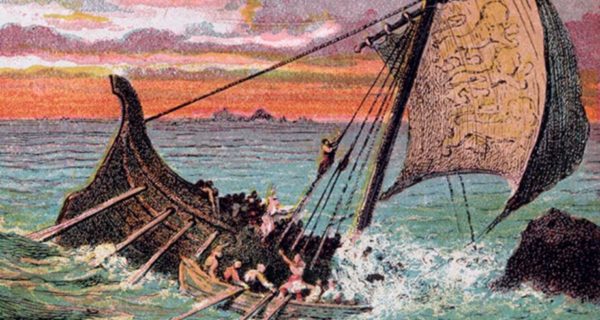While my main focus of interest is usually Lord Nelson and his Navy, today I’m writing about a ship of a very different era: la Blanche-Nef, aka, the White Ship, which sank during the twelfth century, 892 years ago today! While not a particularly noteworthy maritime disaster in terms of its scale, the consequences of its wreckage were of monumental importance to England at the time.
In 1120 the Norman Conquest of England had taken place only just over half a century before and King Henry I is currently on the English throne. The White Ship is a new vessel captained by Thomas FitzStephen, whose father had been captain of the ship Mora, which had been the flagship of William the Conqueror in 1066. The previous year had seen Henry defeat Louis VI of France at the Battle of Bremule.
Now he was ready to return to England and the White Ship, the fastest and most modern ship in the Royal fleet, was offered for his transportation. Henry had already made arrangements but his sons Prince William Adelin, 17, Duke of Normandy, heir-apparent to the throne, and Richard of Lincoln were allowed to return on the White Ship, along with their sister Matilda FitzRoy and many other nobles. There was a total of about 300 people aboard.
On the day of the sailing, Prince William was in a partying mood, and barrels and barrels of wine were brought on board. It didn’t take long before drunken chaos ensued. A few fortunate people felt so ill from drink that they decided to leave the ship and travel home on a later vessel.
When the ship could finally set sail, it was night time, and most of the rest of the fleet were some way ahead. William wanted to be the first to reach England, and everyone was confident that this was possible aboard such a fast vessel. The drunken Master unwisely ordered the oarsmen to row with as much speed as they could muster.
They were not far from the coast of Normandy when the White Ship’s port side struck a rock. The crew unsuccessfully attempted to lever the ship off the rocks, while Prince William was hurried into a small boat. The ship began her quick descent into the depths of the ocean, tipping hundreds of souls into the icy sea.
In great shock, William heard the cry of his sister, Matilda, imploring him to save her, and he ordered the boat to turn around to rescue her. The many panicked passengers in the sea desperately struggled to climb aboard the boat, and, under the weight and strain it capsized. William aged 17, “found his grave at the bottom of the sea”, along with all but two of the ships passengers and crew.
The two survivors, who had clung to the rock that sank the ship, were a butcher from Rouen called Berold and Geoffrey de l’Aigle. It is said that the captain came to the surface, learned of the prince’s fate and allowed himself to drown. It is said that the Kings, having heard the dreadful news, was never able to smile again.
The wreckage of the White Ship caused chaos for England. King Henry had several children but only two, including William, were legitimate, and the other was a daughter, Matilda. Henry, anxious to keep his family on the throne, made his barons swear to recognise his daughter as his heir.
After Henry’s death, Matilda became the first female ruler of England, though her rule was brief and she was never crowned. She was extremely unpopular, a woman ruler was still considered unacceptable then, and she was married to Geoffrey of Anjou, an old enemy of England’s Norman nobles.
Her father’s nephew, Stephen of Blois, usurped the throne while she was away and was supported by most of the barons as wells as her brother, Robert of Gloucester. The ensuing civil war in England and Normandy caused by the succession crisis was known as “The Anarchy” and lasted for almost twenty years. It was finished by a peace treaty in which Stephen acknowledged Matilda’s son, Henry Fitzempress, as his heir.

